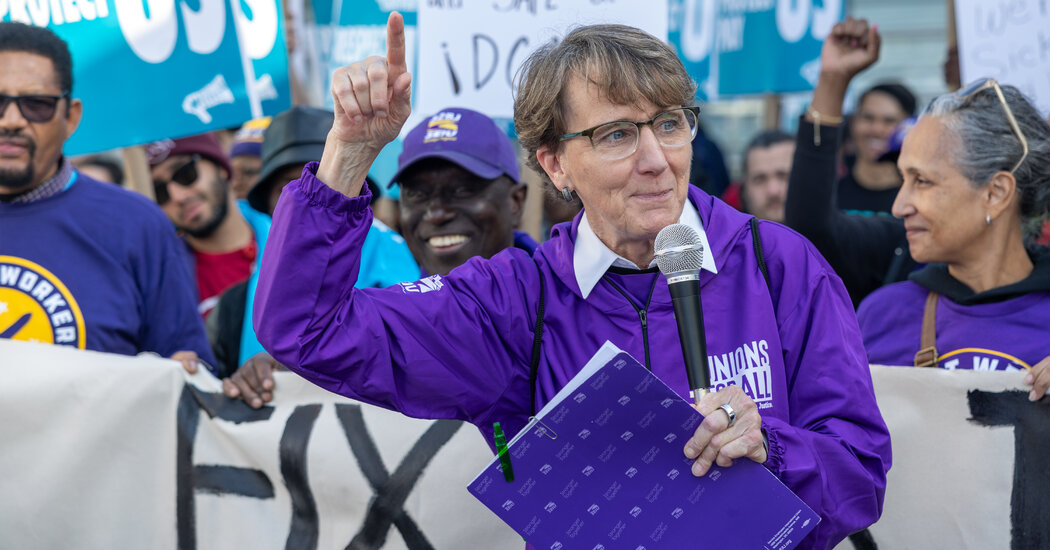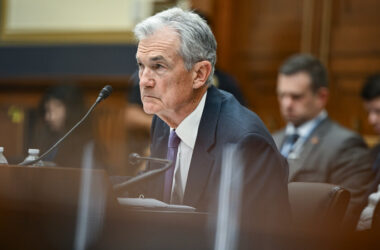Mary Kay Henry, the president of the Service Employees International Union, one of the nation’s largest and most politically powerful labor unions, announced Tuesday that she would step down after 14 years in her position.
Ms. Henry was the first woman elected to lead the union, which represents nearly two million workers like janitors and home health aides in both the public and private sectors.
Under her leadership, it launched a major initiative known as the Fight for $15, which sought to organize fast-food workers and push for a $15 minimum wage. Winning over skeptics in the ranks, Ms. Henry argued that the union could make gains through a broad-based campaign that targeted the industry as a whole rather than individual employers.
Labor experts and industry officials cite the campaign as a major force behind significant minimum-wage increases in states including California and New York and cities like Seattle and Chicago. It also pushed a recent California law creating a council to set a minimum wage in the fast-food industry, which will become $20 an hour in April, and to propose new health and safety standards.
But the Fight for $15 campaign has not unionized workers on a large scale and enabled them to negotiate collective bargaining agreements with their employers.
Ms. Henry’s tenure has coincided with a series of legislative and legal challenges to organized labor, including state laws rolling back collective bargaining rights and allowing workers to opt out of once-mandatory union fees, as well as a landmark Supreme Court ruling allowing government employees to do the same.
The union’s membership has stayed nearly flat on Ms. Henry’s watch, while the overall percentage of Americans represented by unions has declined roughly 15 percent. But the union lost mandatory fees from more than 200,000 nonmembers, causing a significant loss of revenue.
The union will select Ms. Henry’s successor through a vote of delegates at its quadrennial convention in May.
“I’m ready to pass the baton,” Ms. Henry, 66, said in an interview. “S.E.I.U. is packed with powerful, dynamic, multiracial leaders of the next generation who are ready to grab this moment of worker uprising.”
The union’s second-ranking official, Secretary-Treasurer April Verrett, said in an interview that she intended to be a candidate for the top job.
A longtime organizer, Ms. Henry was an executive vice president when the union’s board chose her to fill out the presidential term of Andy Stern, who resigned in 2010. She won the first of three full four-year terms in 2012.
Ms. Henry’s approach has invited criticism that the union is too top-down in its efforts.
The organizer and scholar Jane McAlevey has criticized the Fight for $15 for being too focused on what she calls “mobilizing” — that is, relying heavily on a professional staff, consultants and activists to generate attention and shape public opinion — rather than building an extensive, worker-led organization.
As S.E.I.U. got more involved in a union campaign that an affiliate, Workers United, launched at Starbucks in 2021, some Starbucks workers said decision-making and communications had become more centralized.
In the interview, Ms. Henry rejected the contention that the union’s campaigns did not prominently involve workers, but said it was important to pair ground-level organizing with other strategies that pressured employers. Ms. Henry said the union had sought to invest in the Starbucks campaign, as it was doing in an effort to replace some of the company’s directors, to make it more comprehensive.
The union has also been a force in politics and in policy debates. Ms. Henry took the top job shortly after President Barack Obama signed the Affordable Care Act, which the union had mobilized to help pass. She threw the union into defending the health care legislation against Republican attempts to repeal it.
The union’s political bets under Ms. Henry have not always worked out, like its endorsement of Hillary Clinton early in the 2016 presidential campaign cycle. Many members later became enthusiastic about her Democratic primary rival, Bernie Sanders.
In 2020, the union took a different tack, laying out a policy agenda that it urged candidates to embrace, which included making it easier for workers to bargain on an industrywide basis and making large investments in home care and child care, including increased pay for care workers. Joseph R. Biden Jr. incorporated many of the union’s ideas into his domestic policy platform en route to the presidency.
“It’s an example of how we take stock and evaluate leadership decisions, and draw lessons and think about what we want to do differently next time,” Ms. Henry said of the change in approach.
Still, major home care and child care measures proposed by Mr. Biden died in the Senate.
Ms. Henry said the union was spending heavily on this year’s political elections.
“We want to finish the job,” she said. “We have Senate targets, House targets, governors, state legislators, city councils — to make all the major gains we can make.”




